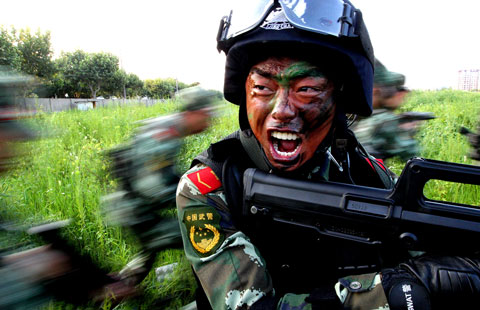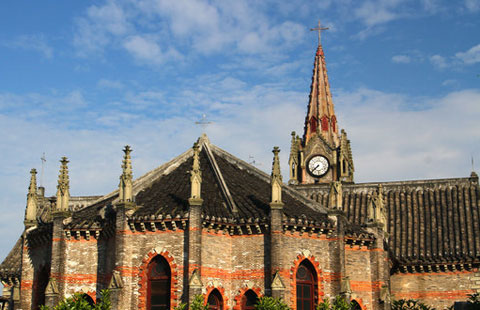
BEIJING - A Beijing-based Tibetology scholar has criticized the Dalai Lama's Friday meeting with US President Barack Obama in the White House, saying it was another "anti-China farce."
"Once again, the Dalai Lama slipped into the White House Map Room for a so-called 'unofficial meeting' with Obama. This was another farce against China," said Lian Xiangmin, a researcher with the China Tibetology Research Center, in a signed article.
The article pointed out that the timing of the meeting reminds people of the special significance of March in the history of Tibet.
On March 10, 1959, a group of high-ranking feudal serfowners in Tibet started an armed rebellion in an attempt to preserve the feudal serfdom. After they failed, the Dalai Lama escaped overseas. Since then, the Dalai Lama and his followers have instigated incidents on March 10 every year in pursuit of a separatist agenda, said the article.
In March 2008 the Dailai clique masterminded, organized and instigated deadly riots in Lhasa.
March also sees the convention of annual sessions of the National People's Congress and the Chinese People's Political Consultative Conference, an important political event for China.
As March is approaching, the Dalai Lama traveled to the United States to meet with Obama, despite his old age. This could only remind people of an old saying, "An owl never comes for no reason, " the article said.
The author said the Dalai clique had adopted various means to achieve so-called "Tibet independence."
On the one hand, they conducted armed harassments and attacks, committed infiltrations and sabotages, created turbulence and trouble to disturb normal life in Tibet. On the other hand, they internationalized the so-called "Tibetan issue" to sensationalize the agenda on various occasions.
They visited countries and regions to seek support from anti-Chinese forces and impose pressure on the Chinese government to achieve their ulterior purpose, the article said.
From 1959 to the end of 1970s, the Dalai Lama and his followers exerted extremist means to pursue "Tibet independence." Since the 1970s, the Dalai clique conspired to achieve "Tibet independence" by several steps under the guise of a "middle way" and "non-violence", according to the article.
No matter how the Dalai clique changed their approach, their attempt to internationalize the "Tibetan issue" has remained the same, the article said.
As the only superpower in the west, the United States has long been the "begging target" for the Dalai clique. For its strategic needs, the US has used the Dalai clique as a "chess piece" to contain China and is ready to embrace the clique, the article said.
The Dalai clique takes for granted that with the backing of the only superpower in the world, there is hope for so-called "Tibet independence." In fact, the US has not met all of the Dalai Lama's demands. The Dalai clique has been treated coldly frequently while it is still willing to be a pawn for the U.S, it said.
Over the past 60 years, the Dalai clique has colluded, taken advantage of and supported each other and internationalized the "Tibetan issue," the article said.
In 1951, ahead of the peaceful liberation of Tibet, the US plotted and supported the reactionary forces of the Tibetan upper classes to resist the People's Liberation Army to liberate Tibet. While its plot to help the Dalai Lama flee Tibet failed, it said.
Before the 1959 rebellion in Tibet, the US Central Intelligence Agency (CIA) trained special agents in Colorado and airdropped them in Tibet to plot and participate in rebellion activities. The CIA also airdropped weapons for the forces, who escorted the Dalai Lama when he fled to India, the article said.
In the 1960s and 1970s, the CIA actively helped the Dalai clique to build their own forces. It also funded India to build a special frontier force together with the Dalai clique to militarily harass Chinese border residents and troops, and attempted to use military means to "fight and go back to Tibet," it said.
According to CIA documents, the US spent 1.7 million US dollars in Tibet-related activities every year. It also manipulated the United Nations to pass resolutions on the so-called "Tibet problem" and tried to internationalize China's internal affairs, it said.
Sino-US relations witnessed an improvement after the 1970s, and the US was less supportive of the Dalai clique. But in 1979 when the two countries normalized diplomatic relations, the US, for the first time in history, accepted the Dalai Lama to the country.
Since the 1980s, the US has given continuous support to the clique. The Dalai Lama has been received by the country's senior politicians on various occasions. In 1991, then President George Bush met the Dalai Lama and in 1997, the US State Department set up a position called "special coordinator for Tibetan issues".
After 2000, the US stepped up its backing for the clique. In 2002, the US Congress passed Tibetan Policy Act, and has held hearings on so-called "Tibetan issues".' The huge financial support the US has lent to the Dalai Lama and his group made the country the Dalai Lama's biggest "benefactor", the article said.
"The Dalai clique, deeply grateful for the US support, hence has a tacit understanding as to what the US needs and is ready to return the favor," the article said.
For years, the clique has made every effort to try to internationalize the "Tibetan issue", hoping to achieve its political aim of "Tibet Independence".
"The only result would be to distance itself from the country and people, drifting further away from the Chinese people, including the Tibetan people," the article said.
Certain country's attempt of using the clique to split China and contain its growth is against the trend of the times and the will of its people, which will never gain support, the article added.








